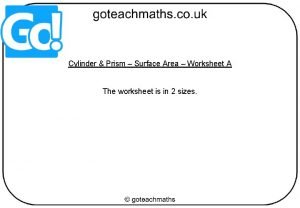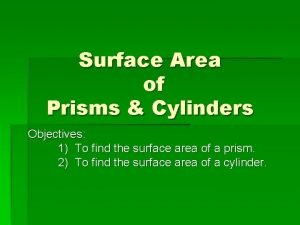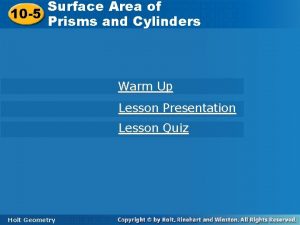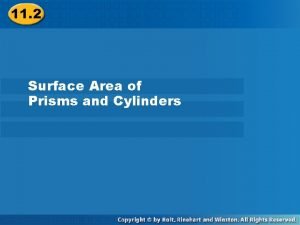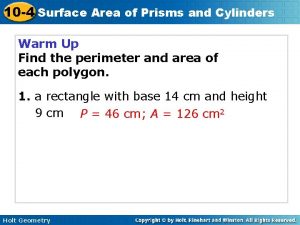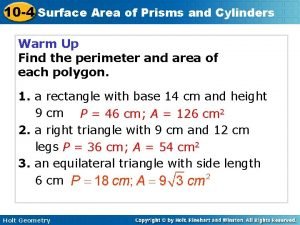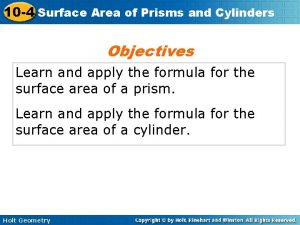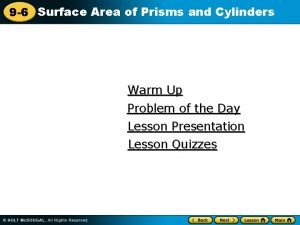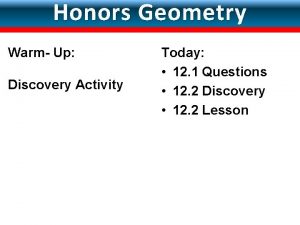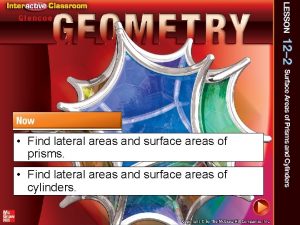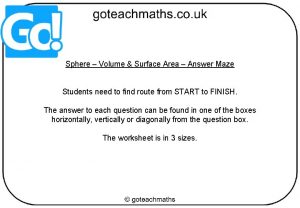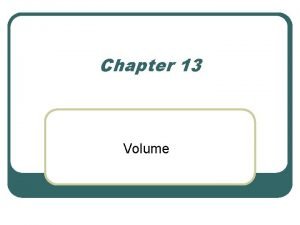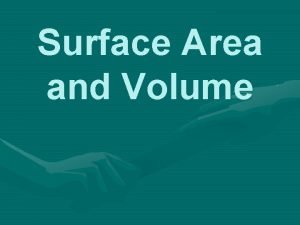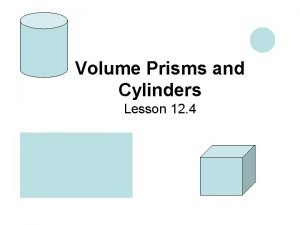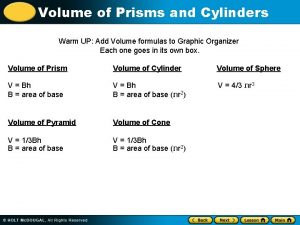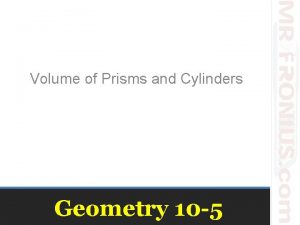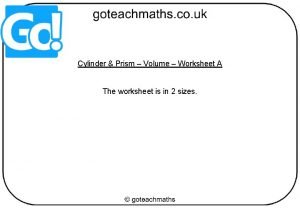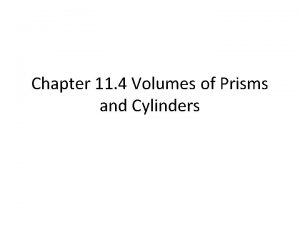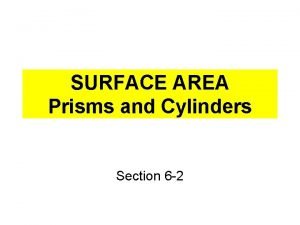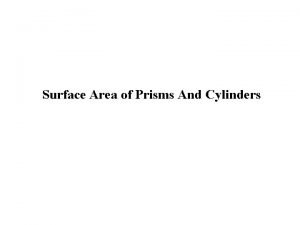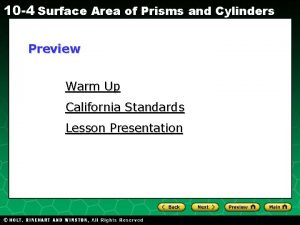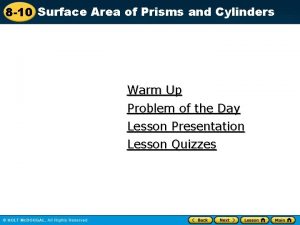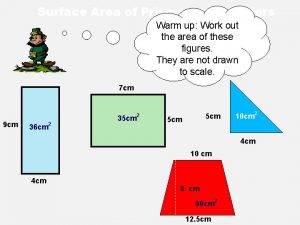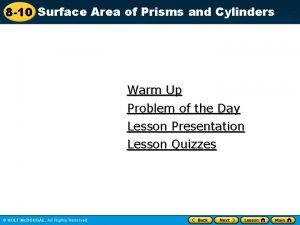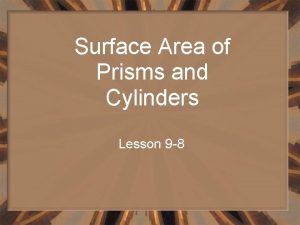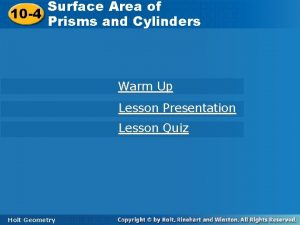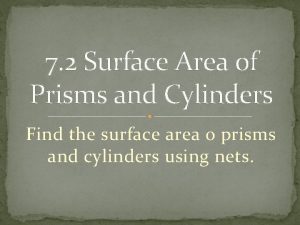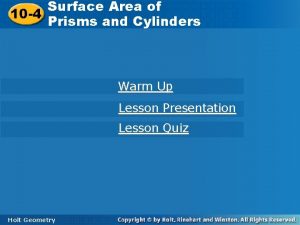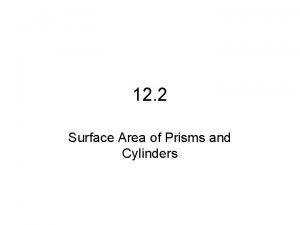10 4 Surface Area of Prisms and Cylinders



















- Slides: 19

10 -4 Surface Area of Prisms and Cylinders Objectives Learn and apply the formula for the surface area of a prism. Learn and apply the formula for the surface area of a cylinder. Holt Geometry

10 -4 Surface Area of Prisms and Cylinders Prisms and cylinders have 2 congruent parallel bases. A lateral face is not a base. The edges of the base are called base edges. A lateral edge is not an edge of a base. The lateral faces of a right prism are all rectangles. An oblique prism has at least one nonrectangular lateral face. Holt Geometry

10 -4 Surface Area of Prisms and Cylinders An altitude of a prism or cylinder is a perpendicular segment joining the planes of the bases. The height of a three-dimensional figure is the length of an altitude. Surface area is the total area of all faces and curved surfaces of a three-dimensional figure. The lateral area of a prism is the sum of the areas of the lateral faces. Holt Geometry

10 -4 Surface Area of Prisms and Cylinders The surface area of a right rectangular prism with length ℓ, width w, and height h can be written as S = 2ℓw + 2 wh + 2ℓh. Holt Geometry

10 -4 Surface Area of Prisms and Cylinders Example 1 A: Finding Lateral Areas and Surface Areas of Prisms Find the lateral area and surface area of the right rectangular prism. Round to the nearest tenth, if necessary. L = Ph P = 2(9) + 2(7) = 32 ft = 32(14) = 448 ft 2 S = Ph + 2 B = 448 + 2(7)(9) = 574 ft 2 Holt Geometry

10 -4 Surface Area of Prisms and Cylinders Example 1 B: Finding Lateral Areas and Surface Areas of Prisms Find the lateral area and surface area of a right regular triangular prism with height 20 cm and base edges of length 10 cm. Round to the nearest tenth, if necessary. L = Ph = 30(20) = 600 cm 2 P = 3(10) = 30 cm S = Ph + 2 B The base area is Holt Geometry

10 -4 Surface Area of Prisms and Cylinders Check It Out! Example 1 Find the lateral area and surface area of a cube with edge length 8 cm. L = Ph = 32(8) = 256 cm 2 P = 4(8) = 32 cm S = Ph + 2 B = 256 + 2(8)(8) = 384 cm 2 Holt Geometry

10 -4 Surface Area of Prisms and Cylinders The lateral surface of a cylinder is the curved surface that connects the two bases. The axis of a cylinder is the segment with endpoints at the centers of the bases. The axis of a right cylinder is perpendicular to its bases. The axis of an oblique cylinder is not perpendicular to its bases. The altitude of a right cylinder is the same length as the axis. Holt Geometry

10 -4 Surface Area of Prisms and Cylinders Holt Geometry

10 -4 Surface Area of Prisms and Cylinders Example 2 A: Finding Lateral Areas and Surface Areas of Right Cylinders Find the lateral area and surface area of the right cylinder. Give your answers in terms of . The radius is half the diameter, or 8 in. L = 2 rh = 2 (8)(10) = 160 in 2 S = L + 2 r 2 = 160 + 2 (8)2 = 288 in 2 Holt Geometry

10 -4 Surface Area of Prisms and Cylinders Check It Out! Example 2 Find the lateral area and surface area of a cylinder with a base area of 49 and a height that is 2 times the radius. Step 1 Use the circumference to find the radius. A = r 2 49 = r 2 r=7 Holt Geometry Area of a circle Substitute 49 for A. Divide both sides by and take the square root.

10 -4 Surface Area of Prisms and Cylinders Check It Out! Example 2 Continued Find the lateral area and surface area of a cylinder with a base area of 49 and a height that is 2 times the radius. Step 2 Use the radius to find the lateral area and surface area. The height is twice the radius, or 14 cm. L = 2 rh = 2 (7)(14)=196 in 2 Lateral area S = L + 2 r 2 = 196 + 2 (7)2 =294 in 2 Surface area Holt Geometry

10 -4 Surface Area of Prisms and Cylinders Example 3: Finding Surface Areas of Composite Three-Dimensional Figures Find the surface area of the composite figure. Holt Geometry

10 -4 Surface Area of Prisms and Cylinders Example 3 Continued The surface area of the rectangular prism is. A right triangular prism is added to the rectangular prism. The surface area of the triangular prism is. Two copies of the rectangular prism base are removed. The area of the base is B = 2(4) = 8 cm 2. Holt Geometry

10 -4 Surface Area of Prisms and Cylinders Example 3 Continued The surface area of the composite figure is the sum of the areas of all surfaces on the exterior of the figure. S = (rectangular prism surface area) + (triangular prism surface area) – 2(rectangular prism base area) S = 52 + 36 – 2(8) = 72 cm 2 Holt Geometry

10 -4 Surface Area of Prisms and Cylinders Example 4: Exploring Effects of Changing Dimensions The edge length of the cube is tripled. Describe the effect on the surface area. Holt Geometry

10 -4 Surface Area of Prisms and Cylinders Example 4 Continued 24 cm original dimensions: edge length tripled: S = 6ℓ 2 = 6(8)2 = 384 cm 2 S = 6ℓ 2 = 6(24)2 = 3456 cm 2 Notice than 3456 = 9(384). If the length, width, and height are tripled, the surface area is multiplied by 32, or 9. Holt Geometry

10 -4 Surface Area of Prisms and Cylinders Check It Out! Example 4 The height and diameter of the cylinder are multiplied by surface area. Holt Geometry . Describe the effect on the

10 -4 Surface Area of Prisms and Cylinders Check It Out! Example 4 Continued 11 cm 7 cm original dimensions: S = 2 (112) + 2 (11)(14) = 550 cm 2 height and diameter halved: S = 2 (5. 52) + 2 (5. 5)(7) = 137. 5 cm 2 Notice than 550 = 4(137. 5). If the dimensions are halved, the surface area is multiplied by Holt Geometry
 Surface area and volume of cylinders and prisms worksheet
Surface area and volume of cylinders and prisms worksheet Find the total surface area of the prism
Find the total surface area of the prism Surface area prisms and cylinders
Surface area prisms and cylinders Surface area of cylinder calculator
Surface area of cylinder calculator 10-4 surface area of prisms and cylinders
10-4 surface area of prisms and cylinders Surface area of prisms and cylinders worksheet
Surface area of prisms and cylinders worksheet Lesson 10-4 surface area of prisms and cylinders
Lesson 10-4 surface area of prisms and cylinders 11-2 surface areas of prisms and cylinders
11-2 surface areas of prisms and cylinders 12-2 surface areas of prisms and cylinders
12-2 surface areas of prisms and cylinders Lateral area of hexagonal prism
Lateral area of hexagonal prism Surface area of a cone
Surface area of a cone Lateral area of a rectangle
Lateral area of a rectangle Volume maze answer key
Volume maze answer key 13-1 practice volumes of prisms and cylinders
13-1 practice volumes of prisms and cylinders Volume and surface area of prisms
Volume and surface area of prisms 12-4 volume of prisms and cylinders
12-4 volume of prisms and cylinders Volumes of prisms and cylinders
Volumes of prisms and cylinders What is the volume of this prism
What is the volume of this prism Quarter cylinder volume formula
Quarter cylinder volume formula 11-4 volumes of prisms and cylinders
11-4 volumes of prisms and cylinders
